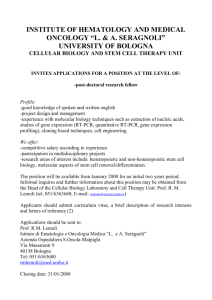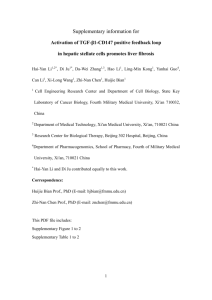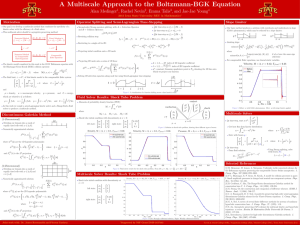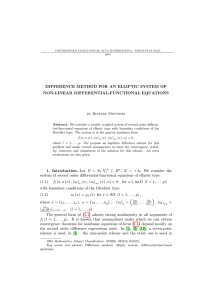Numerical Analysis on Diffusion of dissolved Oxygen in the
advertisement
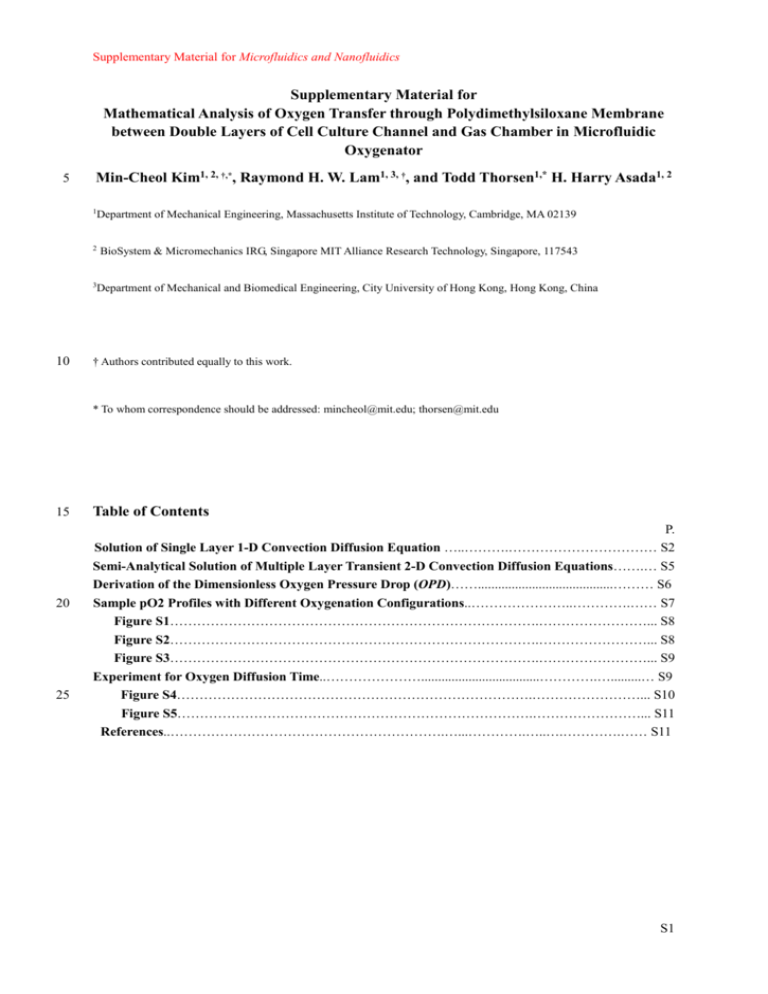
Supplementary Material for Microfluidics and Nanofluidics Supplementary Material for Mathematical Analysis of Oxygen Transfer through Polydimethylsiloxane Membrane between Double Layers of Cell Culture Channel and Gas Chamber in Microfluidic Oxygenator 5 Min-Cheol Kim1, 2, †,*, Raymond H. W. Lam1, 3, †, and Todd Thorsen1,* H. Harry Asada1, 2 1Department 2 BioSystem & Micromechanics IRG, Singapore MIT Alliance Research Technology, Singapore, 117543 3Department 10 of Mechanical Engineering, Massachusetts Institute of Technology, Cambridge, MA 02139 of Mechanical and Biomedical Engineering, City University of Hong Kong, Hong Kong, China † Authors contributed equally to this work. * To whom correspondence should be addressed: mincheol@mit.edu; thorsen@mit.edu 15 20 25 Table of Contents P. Solution of Single Layer 1-D Convection Diffusion Equation …..……….…………………………… S2 Semi-Analytical Solution of Multiple Layer Transient 2-D Convection Diffusion Equations…….… S5 Derivation of the Dimensionless Oxygen Pressure Drop (OPD)……........................................……… S6 Sample pO2 Profiles with Different Oxygenation Configurations..…………………..………….…… S7 Figure S1……………………………………………………………………….……………………... S8 Figure S2……………………………………………………………………….……………………... S8 Figure S3……………………………………………………………………….……………………... S9 Experiment for Oxygen Diffusion Time..…………………...................................………….….........… S9 Figure S4…………………………………………………………………….……………………... S10 Figure S5…………………………………………………………………….……………………... S11 References..…………………………………………………….…...………….…..….………….…… S11 S1 Supplementary Material for Microfluidics and Nanofluidics Solution of Single Layer 1-D Convection Diffusion Equation The dimensionless 1-D convective diffusion equation and boundary conditions are expressed as i2 gi 2 gi mi 2 5 gi gi for i 1 i and 0 1 (S1) Sh Gi ( , ) g ( , , ) (S2) Sh g ( , , ) Gi 1 ( , ) (S3) i 1 i h K ( ) where Sh N is Sherwood number (Sh) representing the ratio of length scale to the diffusive Di boundary layer thickness (hN), and K ( ) is the film mass transfer coefficient at the boundary . To solve this non-homogeneous boundary value problem, we may let 2 gi , , vi , , Lij Fij , for i 1 i and 0 1, 0 10 (S4) j 1 where d 2 Lij ( ) d 2 0 so that Lij ( ) Cij1 Cij2 for i 1 i and 0 1, i 1, 2,..., N , j 1, 2. Fi1 , Gi , and Fi 2 , Gi 1 , are unknown variables at boundaries of the ith material. Substituting these results into Eq. S1 gives i2 15 2 Fij ( , ) 2 vi vi i2 Lij ( ) mi . 2 j 1 (S5) The boundary conditions described in Eqs. S2-S3 are decomposed as (39) Di vi ( , i 1 , ) hN K (i 1 )v( , i 1 , ) 0 (S6) Di vi ( , i , ) hN K (i )v( , i , ) 0 (S7) Di dLi1 (i 1 ) hN K (i 1 ) Li1 (i 1 ) hN K (i 1 ) d (S8) Di 20 dLi1 (i ) hN K ( i ) Li1 ( i ) 0 d (S9) Di dLi 2 (i 1 ) hN K (i 1 ) Li 2 (i 1 ) 0 d (S10) Di dLi 2 (i ) hN K (i ) Li 2 (i ) hN K ( i ) d (S11) where Eqs. S8-S9 and S10-S11 are boundary conditions used to solve Li1 ( ) and Li 2 ( ) , respectively. Assuming K ( i 1 ), K ( i ) , the solutions of Li1 ( ) and Li 2 ( ) are Li1 ( ) 25 i i 1 , Li 2 ( ) i i 1 i i 1 (S12) with the initial condition S2 Supplementary Material for Microfluidics and Nanofluidics 2 2 j 1 j 1 vi ( , , 0 ) gi ( , , 0 ) Lij ( ) Fij ( , 0 ) fi ( , ) Lij ( ) Fij ( , 0 ) (S13) . Now, we may let vi , , Vi , n , i , n i 1 i , 0 1, 0 n 1 mi , , M i , n , i , n i 1 i , 0 1, 0 n 1 i 5 where M i , n , i 1 (S14) (S15) mi , , i , n d i . i , n d 2 i 1 i Assume Lij ( ) lij , n i , n for i 1 i , where lij , n n 1 i 1 Lij ( ) i , n d i i 1 i , n d 2 , and substituting Eqs. S14 and S15 into Eq. S5: 2 i 2Vi , n , i , n i 2 lij , n j 1 Fij , i , n M i , n , i , n i , n Vi , n , (S16) Dividing Eq. S16 by i 2 Vi ,n , i ,n yields 2 Vi , n , lij , n j 1 10 Fij , Vi , n , M i , n , i 2 i , n i 2 i , n i2,n (S17) where a positive constant i2,n is used to set the above equation to be negative, such that the corresponding two ordinary differential equations are 2 Vi , n , i2, nVi , n , lij , n j 1 Fij , i ,n i2,ni 2 i ,n 0 15 M i , n , i 2 (S18) (S19) where the boundary conditions of eigenfunction in Eq. S19 are Di i , n i 1 hN K (i 1 )i ,n i 1 0 (S20) Di i , n i hN K (i )i ,n i 0 . (S21) Hence the solution of Eq. S19 is i ,n Ai ,n Cos(i ,n . Substituting this solution into Eqs. i ) Bi , n Sin(i , n i ) S20-S21 gives a matrix form as 20 Di i , n i Sin(i , n i i 1 ) hN K ( i 1 )Cos(i , n i i 1 ) Di i , n i Cos(i , n i i 1 ) hN K ( i 1 ) Sin(i , n i i 1 ) Ai , n 0 (S22) Di i , n i Cos (i , n i i ) hN K ( i ) Sin(i , n i i ) Bi , n 0 Di i , n i Sin(i , n i i ) hN K ( i )Cos (i , n i i ) The orthogonality of the eigenstates, Cos(i ,n and Sin(i,n , lead to a condition for the eingenvalue i ) i ) spectrum: S3 Supplementary Material for Microfluidics and Nanofluidics Di i , n i Sin(i , n i i 1 ) hN K ( i 1 )Cos (i , n i i 1 ) Di i , n i Cos (i , n i i 1 ) hN K ( i 1 ) Sin(i , n i i 1 ) 0 (S23) Di i , n i Sin(i , n i i ) hN K ( i )Cos (i , n i i ) Di i , n i Cos (i , n i i ) hN K ( i ) Sin(i , n i i ) . K (hi ), K (hi 1 ) , the corresponding eigenvalues are i ,n n 2 2 i2 i i 1 2 . This However, as Sturm-Louisville problem has been solved by implementing separation of variables on the homogeneous BVP of Eqs. S7-S8. The General solution for Eq. S18 at a simulation time is integrated from initial time 0 that 5 yields an expression written as Vi , n , Vi , n , 0 Exp i2, n ( 0 ) 2 Fij ( , ) j 1 0 lij , n Exp i2, n ( ) d 1 i 2 0 (S24) M i , n , Exp i2, n ( ) d where Vi ,n , 0 can be calculated with the initial condition Eq. S13: 2 fi ( , ) Lij ( ) Fij ( , 0 ) i , n d i 1 j 1 i 2 d i,n i Vi , n , 0 i 1 i Define i , n fi ( ) i i 1 fi ( , ) i , n d i i 1 i , n d 2 2 lij , n Fij ( , 0 ) . f ( ) i , n d i 1 i i 1 i , n d 2 in Eq. S25 and we obtain 2 Vi , n , i , n fi ( , ) lij , n Fij ( , 0 ) Exp n 2 ( 0 ) j 1 . 2 Fij ( , ) 1 2 2 lij , n Exp i , n ( ) d 2 M i , n , Exp i , n ( ) d 0 i 0 j 1 10 By assuming Fij ( , ) (S25) j 1 (S26) a j and M i ,n , Mi ,n , 0 for the convolution terms in the above equation, Eq. S26 becomes 2 Vi , n , i , n fi ( , ) lij , n Fij ( , 0 ) Exp i , n 2 ( 0 ) j 1 1 M i , n , 0 2 lij , n a j 1 Exp i , n 2 ( 0 ) i , n 2 i 2 j 1 where a j 15 Fij ( , ) Fij ( , 0 ) 0 (S27) . Updating 1 0 , where τ1 is the current simulation time and Δτ is the time step, into Eq. S27 gives 2 Vi , n , 1 i , n f i ( , ) lij , n Fij ( , 0 ) Exp i , n 2 j 1 Fij ( , 1 ) Fij ( , 0 ) 1 M i , n , 0 2 2 lij , n 1 Exp i , n i , n 2 i 2 j 1 . When Fij ( , ) Fij ( , ) Fij ( , 0 ) 0 (S28) and M i ,n , Mi ,n , 0 , S4 Supplementary Material for Microfluidics and Nanofluidics i , n f i ( , ) li1, nGi ( , 0 ) li 2, nGi 1 ( , 0 ) Exp n 2 gi , , 1 M i , n , 0 Gi ( , ) Gi ( , 0 ) Gi 1 ( , ) Gi 1 ( , 0 ) 2 n 1 li1, n li1, n 1 Exp i , n 2 i 2 i , n i , n Li1 ( )Gi ( , ) Li 2 ( )Gi 1 ( , ). (S29) Semi-Analytical Solution of Multiple Layer Transient 2-D Convection Diffusion Equations 5 To impose the dimensionless mass flux boundary conditions Eqs. 18, 20 and 22, the spatial derivative of gi , , should be calculated as g i , , 10 i , n f i ( , ) li1, n Gi ( , 0 ) li 2, n Gi 1 ( , 0 ) Exp i , n 2 1 M i , n , 0 Gi ( , ) Gi ( , 0 ) Gi 1 ( , ) Gi 1 ( , 0 ) 2 n 1 li1, n li1, n 1 Exp i , n 2 2 i i , n d i , n , d dLi1 ( , ) dL ( , ) Gi ( , ) i 2 Gi 1 ( , ) d d (S30) where 0 and are the dimensionless priori time of iteration and time-step, respectively. Rearrange Eq. S30 as a linear combination of unknown variables and source term: gi , , Qi , , Gi ( , ) Ri , , Gi 1 ( , ) Pi , , 0 , (S31) Where Pi , , 0 , is the source term, Qi , , and Ri , , are the coefficients of unknown variables, which are expressed as S1 15 i , n f i ( , ) li1, n Gi ( , 0 ) li 2, n Gi 1 ( , 0 ) Exp i , n 2 Pi , , 0 , 1 M i , n , 0 li1, n Gi ( , 0 ) li 2, n Gi 1 ( , 0 ) 2 n 1 1 Exp i , n 2 i 2 i , n Qi , , Ri , , 1 dLi1 ( , ) li1, n d 1 Exp dLi 2 ( , ) li 2, n d 1 Exp n 1 n 1 2 2 i,n i,n 1 2 i,n i,n d i , n , d (S32) d i , n , d 2 d i , n , d (S33) . (S34) Using the mass flux boundary conditions, Eqs. 18, 20, 22 and 23 can be converted into linear algebraic equations written as a matrix form: 20 R1 , 0, Q1 , 0, 1 Q , , 1 R , , Q , , 1 1 1 1 2 1 A 12 12 2 0 3 2 Q2 , 2 , 0 0 0 R2 , 1 , 32 2 R2 , 2 , Q3 , 2 , 0 0 R3 , 2 , 1 0 , S5 Supplementary Material for Microfluidics and Nanofluidics P1 , 0, 0 , G1 ( , ) 1 P , , , P , , , G ( , ) 1 1 0 2 1 0 . and X 2 b 12 G3 ( , ) 2 3 2 P2 , 2 , 0 , P3 , 2 , 0 , G4 ( , ) 0 (S35) These linear equations A(ξ)·X(ξ) = b(ξ) are readily solved line-by-line along to the channel axial direction (0 ≤ ξ ≤ 1) using tridiagonal matrix algorithm (TDMA)S2. 5 Derivation of the Dimensionless Oxygen Pressure Drop (OPD) When the mass fluxes of oxygen across each material layer are identical, it can be expressed as q D3 S3 2 D2 S2 2D S Pg P2 3 P23 P2b 2 2 P2b Pcell H3 H2 H2 (S36) where P2-3 is the pO2 at the interface between PDMS membrane and medium channel, P2b is the 10 bulk pO2 in medium, and Pcell is the pO2 along top cell surface. If we correlate q with the cellular oxygen uptake rate at the equilibrium state, q can be written as q D1 c1 y y H cell H1 0 Vmax cell c1 V c V * P dy max cell 1 H1 max cell cell K m c1 S1 K m c1 K m Pcell (S37) where ρ*cell (= ρcell H1) is the cell density [cells/cm2]. Equation (S36) can be converted by following equation: q 15 P g P2 3 P2 3 P2 b P2 b Pcell . H3 H2 D3 S3 D2 S2 (S38) With equations (S37) and (S38), a quadratic equation with a variable Pcell can be expressed as H H * Pcell 2 3 2 Vmax cell Km Pg Pcell Pg Km 0. D3 S3 D2 S2 (S39) By dividing each term by Pg 2 , equation (S39) yields Pcell Pg 20 2 H3 K P K H V * 2 max cell m cell m 0. 1 Pg Pg Pg D3 S3 D2 S2 Pg To further simplify the equation (S40), we define A K 'm Pg and B * Vmax cell Pg (S40) H3 H2 D S D 2 S2 3 3 , and it is simplified in following form: Pcell Pg Solving for 2 P 1 A B cell A 0. Pg (S41) Pcell gives Pg S6 Supplementary Material for Microfluidics and Nanofluidics Pcell 1 A B Pg 1 A B 2 4A 2 (S42) . We define the dimensionless oxygen pressure drop (OPD) between the top cell surface and gas reservoir as OPD 5 Pg Pcell Pg (S43) , and its exact solution can be simplified in following form: OPD Pg Pcell Pg 1 1 1 A B 2 2 1 A B 2 4 A. (S44) Sample pO2 Profiles with Different Oxygenation Configurations 10 Fig. S1(a-d) shows contour plots of the partial pO2 for four cases with different PDMS membrane thicknesses (H3) 50 µm, 250 µm, 1000 µm and 6000 µm, respectively, at the steady state. For the qualitative comparison, the cell layer thickness (H1 = 5 µm), effective channel height (H2 = 195 µm), medium flow rate (Pe = 3), cellular oxygen uptake rate (Vmax = 4 × 10-17 mole/cell/s), surface cell coverage (ρ*cell = 3 × 104 cells/cm2) and Michaelis–Menten constant (K’m = 0.5 mmHg) were set to be identical for the four different PDMS membrane 15 cases. The plots show that the developing length of pO2 (the length where medium starts being fully diffused, or x for L* ~ 1) increases with the membrane thickness, which is related to the diffusive resistance. Another parametric study was conducted to investigate how the developing length relates to the effective channel height under the same Peclet number (Pe = 6) and same surface cell coverage (ρ*cell = 3 × 104 cells/cm2). Fig. S2(a-d) shows contour plots of the partial pO2 in four different effective channel heights (H2) 50 µm, 100 20 µm, 250 µm and 500 µm, respectively, at the steady state with fixed cell layer thickness (H1 = 5 µm) and PDMS thickness (H3 = 250 µm). All other parameters were the same as Fig. S1. The height of medium channel has similar effects on the diffusion time and developing length as the PDMS thickness. Furthermore, Fig. S3(a-e) shows contour plots of the partial pO2 in five different cell layer thickness (H1) 10 µm, 20 µm, 50 µm, 100 µm and 150 µm, respectively, under steady state conditions with a fixed channel 25 height (Hc = 200 µm) and PDMS thickness (H3 = 250 µm), and with all other parameters identical to the PDMS thickness study illustrated in Fig. S1. The developing length of pO2 gradually decreases as the cell layer grows in a limited culture channel (constant height: Hc = H1 + H2), inducing an increasing volumetric ratio of cell layer to medium, because the diffusive resistance of HUVEC (H1/S1D1) is smaller than that of culture medium (H2/S2D2). S7 Supplementary Material for Microfluidics and Nanofluidics Figure S1: Contour plots of partial pO2 in a cross section of microfluidic device with H1 of 5 µm, H2 of 195 µm, and four values of H3, i.e. (a) 50 µm, (b) 250 µm, (c) 1000 µm and (d) 6000 µm. Each case was simulated under identical conditions with the dimensionless parameters Pe = 3, Da = 3.93. 5 Figure S2: Contour plots of the partial pO2 in the microfluidic devices with H1 = 5 µm, H3 = 250 µm, and four different H2: (a) 50 µm, (b) 100 µm, (c) 250 µm and (d) 500 µm. Each case was simulated under identical conditions with the dimensionless parameters Pe = 6 and Da = 0.98, 1.96, 4.91 and 9.83 for (a) – (d), 10 respectively. S8 Supplementary Material for Microfluidics and Nanofluidics Figure S3: Contour plots of the partial pO2 in the microfluidic devices with Hc = 200 µm, H3 = 250 µm, and five different H1: (a) 10 µm, (b) 20 µm, (c) 50 µm, (d) 100 µm and (e) 150 µm. Each case was simulated under identical conditions with the dimensionless parameters Pe = 6 and Da = 7.86, 15.73, 39.32, 78.64 and 117.96 for 5 (a) – (e), respectively. Experiment for Oxygen Diffusion Time Chip fabrication 10 Experiments were performed to validate the simulated dissolved-oxygen (DO) concentration inside an elastomeric PDMS channel. Microfluidic chips containing arrays of double-layer structures (as described in the Diffusion Time of Oxygen Transfer section) with different layer thicknesses were fabricated by multilayer soft lithographyS3 as shown in Fig. S4. Geometry of air and fluid channels was defined by SU-8/silicon molds, in which SU-8 negative photoresist (Microchem SU-8 50) was patterned on a silicon wafer. After cleaning a 3” 15 silicon wafer (James River Semiconductors), SU-8 (thickness: 100 µm) was spin-coated (1000 rpm, 30 s) on the wafer and patterned by photolithography (Karl Suss Mask Aligner MJB3, 2 min exposure). Afterwards the mold was silanized with a high molecular weight trichloro-perfluorooctyl silane (Aldrich) for >5 min to reduce the adhesion between polydimethylsiloxane (PDMS) and the Si/SU-8 surface. A mixture of 10:1 PDMS monomer/harder (Sylgard 184, Dow Corning) was prepared and poured onto the mold with the gas channel 20 pattern before baking at 80 °C for 2 hr. Another 10:1 PDMS monomer/harder mixture was spin-coated (for H2 + H3 ≤ 1000 μm) or poured (for H2 + H3 > 1000 μm) on the flow channel mold with the defined thickness (100 µm) and was then baked in an oven at 80 °C for 10 min. Taken out the gas layer mold from the oven, the PDMS substrate was cut and peeled off from the mold. After punching holes for the gas inlets and outlets, the gas layer was aligned onto the mold with the PDMS medium layer under a dissecting scope (Olympus, Model SZX9). To 25 achieve permanent bonding and fully-cured PDMS, the whole PDMS substrate was post-baked in an oven at 80 ºC for >10 hr. The bonded PDMS was then chopped, peeled off and punched for medium inlets and outlets. On the other hand, a glass substrate containing DO sensors was prepared from a glass slide (75 mm (l) × 25 mm (w) × 1 mm (h)). Each sensor region on the glass slide was etched with buffered hydrofluoric acid (7 H 2O: 1 HF) for S9 Supplementary Material for Microfluidics and Nanofluidics 5 min to produce a cavity (~5 μm). A polymeric sensor film was then deposited in each cavity by applying a droplet (~1 μL) of PtOEPK/polystyrene dye solution, prepared by first dissolving PtOEPK (Frontier Scientific, w/w 0.1 %) and polystyrene (w/w 5 %) into toluene. After toluene in the dye solution evaporates, oxygen-permeable PtOEPK/polystyrene films (thickness: ~3 μm) were formed as DO sensors. The PDMS and 5 glass substrates were then bonded by oxygen-plasma bonding process (PLASMOD, Tegal Corporation) with 600 mTorr pressure and medium power for 45 s. Figure S4: 10 (a) Photograph and schematic diagrams of (b) top view and (c) cross-section of a PDMS chip for validation of diffusion time. Experimental procedures and sample results To measure the time-varying DO profile at the sensor layer, oxygen was continuously supplied along gas layer. Real-time measurement was achieved by a detection method based on the Stern-Volmer relation of PtOEPK that 15 the reduction in luminescent intensity of sensing material due to oxygen quenching of the emitting excited electronic state S4, S5 . In the experiment, the medium channel was initially filled with fresh medium under ambient environmental partial pressure and oxygen was then applied along the gas channel. The corresponding numerical oxygen profiles were also calculated using the approach described in section 4-2. Comparisons of the computational and experimental dynamic sensor responses indicate that the devices had similar pO2 profiles 20 (Fig. S5) and response/rise time as numerical solution. S10 Supplementary Material for Microfluidics and Nanofluidics 5 Figure S5: Sample sensor responses in the validation experiment of diffusion time and the corresponding simulation results for sensor thickness (H1) 3 μm, effective medium channel height (H2) ~100 μm and membrane thickness (H3) (a) 20 μm, (b) 100 μm, (c) 300μm , and (d) 1250 μm. The y axes were normalized by scaling the fully saturated DO as value 1. References S1 G. P. Mulholland and M. H. Cobble, Int. J. Heat Mass Transfer., 1972, 15, 147–160. 10 S2 T. P. Fredman, Heat and Mass Transfer., 2003, 39, 285–295. S3 T. Thorsen, S. J. Maerkl and S. R. Quake, Science., 2002, 298, 580–584. S4 R. H. W. Lam, M.-C. Kim and T. Thorsen, Anal. Chem., 2009, 81, 5918–5924. S5 A. P. Vollmer, R. F. Prostein, R. Gilbert and T. Thorsen, Lab Chip., 2005, 5, 1059–1066. S11
